A short history of the
Silander-McWalter family
Herbert George Silander and Marion Howie McWalter are my paternal grandparents. This short history relates what I have found out about them and their children. I did not know either of them and what follows is information gathered from oral history (some of it supplied by Renée Houston's sons Alan Aherne and Tony Aherne aka John Lyall), personal recollection, old photographs and official records.
Herbert was born in Gothenburg, Sweden in 1876, the eldest son of Carl Johan Andersson and Christina Johansdotter, who were both descended from crofters, small farmers and agricultural labourers in the country areas around Gothenburg in south-west Sweden. Herbert was christened Herbert Georg Andersson, though his surname could just as easily have been Carlsson if they had followed the outgoing patronymic system. The law had changed to allow the populace to have surnames, and then changed again to ensure that they all had surnames. It seems that it was quite common in Sweden at this time to choose your own surname, and he chose the Silander name recently adopted by his aunt, and possibly based on his uncle's choice of Selander 20 years earlier.
Herbert's mother Christina died in 1891 when he was 15 and his youngest sibling, Agnes Kristina, was only 5. After Christina's death, it appears that her younger, unmarried sister Lovisa looked after the family. Lovisa eventually formally adopted Agnes Kristina, and the widowed Carl re-married and returned to his rural origins in Kungsbacka south of Gothenburg. According to my Swedish cousin Harald, Agnes Kristina became a school-teacher, and one of her brothers became a tram driver.
Herbert worked in Gothenburg as a book-keeper for a Scottish lace-making firm which was based in Newmilns (Johnstone Shields) and at the age of 18 he left Sweden for Newmilns. As far as I know, he never returned. Possibly, this was partly due to the recent death of his mother and his father's subsequent re-marriage as much as a desire for foreign travel.
Incidentally, the Scottish lace workers that he left behind in Gothenburg are credited with introducing football to Sweden. (From a reference book in the Dick Institute, possibly Historical Aspects of Newmilns, published in 1990.)
Herbert's wife Marion, also known later as May, was born in the Ayrshire mining village of Muirkirk, also in 1876. She was the third of 9 children born to Thomas McWalter, a coal miner, and Elizabeth Hutchison.
Marion's father Thomas was born in Dundee and descended from an Irish weaver and a Scottish mother from Edinburgh. The family moved from Dundee to Wigtownshire and then finally to Galston in Ayrshire, just a few miles up the River Irvine from Kilmarnock and just a couple of miles from Newmilns.
Her mother Elizabeth was born in Galston and all her ancestors seem to have been Ayrshire folk; Hutchison from Galston; Howie from Drumcloich farm, Fenwick; Shinnan from Craigie and possibly of Irish descent. Fenwick and Craigie are villages just outside Kilmarnock. The Howies of Lochgoin were Covenanters, and as Lochgoin is only a few miles from Drumcloich, it is possible that the two families were related and that my Howie ancestors were Covenanters.
This historical information was obtained from the Future Museum South West Scotland website (futuremuseum.co.uk).
The Covenanters were ardent supporters of the Presbyterian Church, their faith being based on the teachings of John Calvin and John Knox. Their name comes from the National Covenant of 1638, an oath to resist the attempts by Charles I to introduce a new Prayer Book in Scotland. It was an opposition that would eventually lead to 18,000 of them losing their lives in a bloody struggle and the Presbyterian Church becoming the official religion of Scotland.
Lochgoin farm was the home of John Howie, the author of 'The Scots Worthies' an incredibly popular book throughout Scotland when it was published in the 18th century. It is an account of the lives of some of the Covenanters and the persecution they endured.
John Howie's great grandfather was among these men and his farm was often used to shelter other Covenanters when they were under threat. The Howies still possess the farm and it now holds a small collection of Covenanting relics. The Lochgoin monument is nearby.
The Scottish Covenanters website is also interesting (scottishcovenanters.org), but no longer exists.
After their marriage, Thomas and Elizabeth moved around the coalfield, presumably following the availability of work, first Galston, Muirkirk and Newmilns in Ayrshire and then Hamilton and Blantyre in Lanarkshire.
I know nothing of Marion's childhood until the 1891 Census lists her working as a domestic servant in Hamilton at the age of 15. At the time of her marriage in 1898 she was working as a spool winder in a lace mill in Newmilns and living in Brown Street.
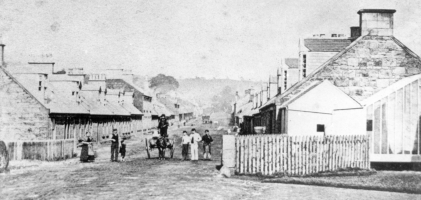
Brown Street, Greenholm, Newmilns. About 1900.
© Ayrshire Archives
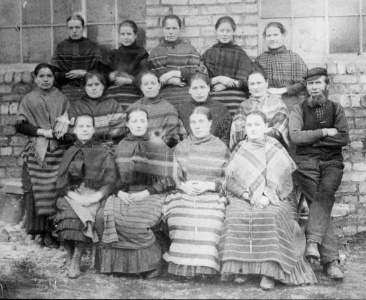
Newmilns lace mill workers around 1880-1900.
© Ayrshire Archives
The following pictures illustrate the expansion and industrialisation of Newmilns resulting from the building of 11 textiles-related factories in the 1880s and 1890s. These were built on the south bank of the River Irvine in Greenholm. The south bank is in Galston Parish, while the original Newmilns on the north bank is in Loudoun Parish. The village of just under 3,000 inhabitants grew by over 60% in 30 years.
There are 7 factories in this photograph of Greenholm, though only the chimneys of some are visible. Front left is the bleachworks where Herbert was works manager when he died. Just visible, fourth from the left is the roof of the factory where he worked when he arrived from Sweden.
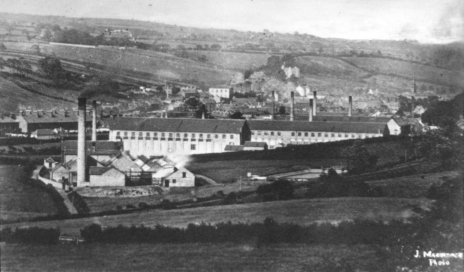
Industrial Newmilns around 1900.
© Ayrshire Archives
These photographs of Newmilns from the north west show the west end of Newmilns and Greenholm. It was common for a blanket of smoke to cover the town as coal fires burned night and day in every home and factory and in the local gas-works.
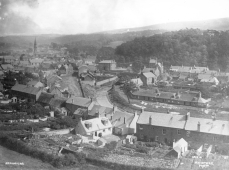
Newmilns west end.
© Ayrshire Archives
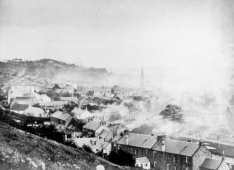
Smoky Newmilns.
© Ayrshire Archives
Herbert and Marion married in 1898. They were both working in Newmilns and they spent all of their married life there. Herbert progressed well in his work, from warehouseman to works manager, and as their standard of living improved they moved house several times, finally living in Brookfield, Loudoun Road. They had five children; Bert 1904, Claire 1907, Thomas 1909, John 1911 and Hal 1913; Thomas and John died in infancy.
Herbert was an Alien until he took the Oath of Allegiance under The Naturalization Act, 1870. According to the London Gazette, November 1, 1907, he took the oath on 11th October 1907 and it was registered in the Home Office.
Bert & Claire were born in Clifton. Although it was a side street, it was originally addressed as Loudoun Road, but then became Mure Place. Clifton is 1 Mure Place and is the left-most semi-detached bungalow in the picture.
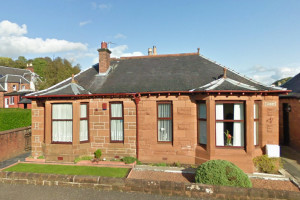
Clifton
Loudoun Road is the main road west to Galston and Kilmarnock and quite a few new houses were built here in the 1880s and 1890s to accommodate the growing population.
Thomas & John were born in Bank House, famous architecturally. It is now a listed building known as Lamlash House. It was sometimes named Bank House; it is on the river bank; and sometimes Royal Bank House; there was a branch of RBS in this building for many years. It is in Greenholm, just on the other side of the River Irvine.
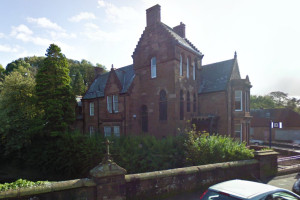
Bank House, now Lamlash House
Hal was born in Riverbank, which is a cottage that was 1 Main Street, on the Newmilns side of the river. Strangely, it is on the even-numbered side of the street. Riverbank has since been re-numbered, and is now 2 residences, but the first house on the other side is still number 3.
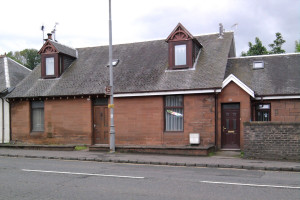
Riverbank
Their last house was Brookfield on Loudoun Road, the left half of the villa. This is the only house that I know they owned. I have not checked Clifton and Bank House and Riverbank were rented.
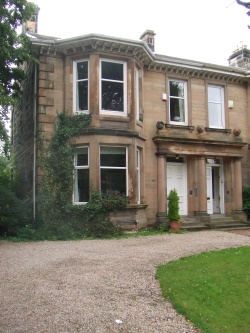
Brookfield
Their first-born was Bert, christened Herbert George after his father, and known both as Bert and Herbert. Probably Herbert in his youth and mostly Bert later.
Bert was in the Boy Scouts, which were started by Baden-Powell in 1908. This picture was taken about 1914 and Bert is seated on the grass, 2nd from the front and just left of centre.
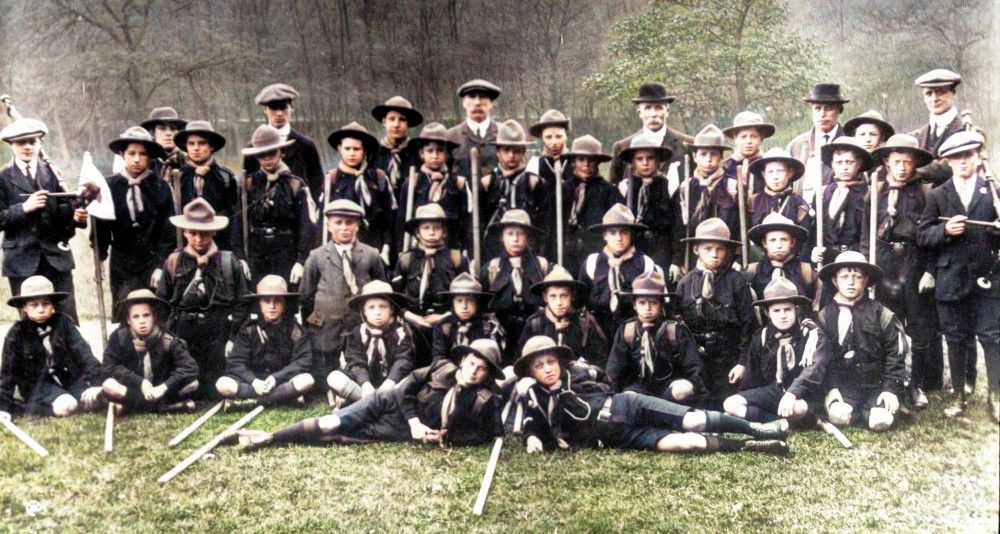
Newmilns Boy Scouts. About 1914. © Ayrshire Archives
These photographs show Bert as a Scout and as a Junior Ayrshire Volunteer; he could have been in both at the same time, possibly 1917 / 1918, during World War I.
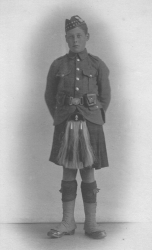
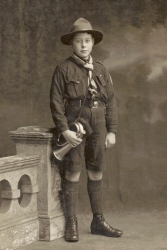
Herbert and Marion's second child was Claire, who was christened Elizabeth McWalter and was known as Bessie. It was her husband Jim who decided that she should be Claire and her married name was Elizabeth Claire Rennie. She was a member of the Girl Guides and retained a long connection with the movement; I know that in the 1960s she was a Guide Commissioner.
Their youngest was Harold who was born in 1913 and was later known as Hal. He had a varied working life, including business manager for the Houston Sisters, a food inspector during the war, a cinema manager in Reading and the landlord of the Royal Deer pub in Farnham, Surrey.
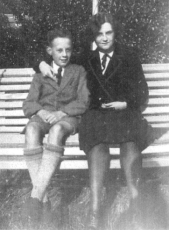
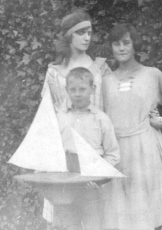
Claire and Hal, about 1920 and 1923.
This is Herbert senior. It looks like they had a large garden where they kept hens, probably Brookfield. (Another picture in the same set includes a young Hal and dates them to about 1920. See the explanation in Silander Pictures.)
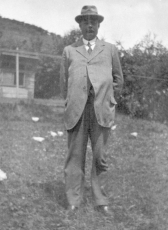
Herbert senior
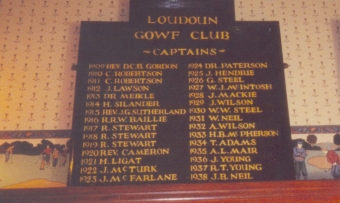
They all played golf at Loudoun Gowf Club and Herbert senior was captain in 1914. He was their auditor in later years.
Herbert senior also bowled and he could be in this picture, but I have not been able to identify him. The bowling green is on the south side of the river in Greenholm.
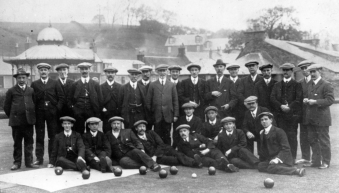
Newmilns Bowling Club. 1920s.
© Ayrshire Archives
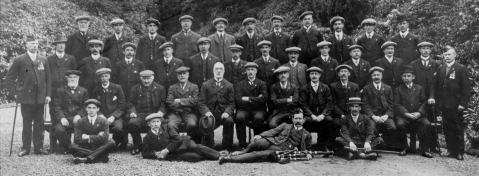
Newmilns Army Reserves about 1916.
© Ayrshire Archives
During World War I (1914-1918), conscription was introduced in 1916 and even more of the young men were sent to the battlefields. The response from those left behind, either too old or in reserved occupations, was to join the local military unit. This picture shows the Newmilns Volunteers. Herbert senior should be here as he was a Temporary Second Lieutenant in the 2nd Voluntary Battalion of the Royal Scots Fusiliers. But again I have not been able to identify him.
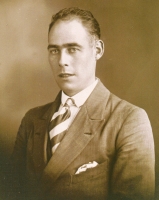
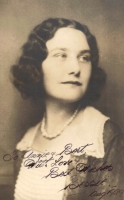
Bert and Bessie both had studio portraits taken when they were 21. So these pictures were taken in 1925 and 1929.
About 1928, Bert began courting Annie Cargill, who lived in Kilmarnock. They met at a Western SMT staff party, possibly at Christmas.
Coincidentally, Annie & Bessie were in the same year at Kilmarnock Academy.
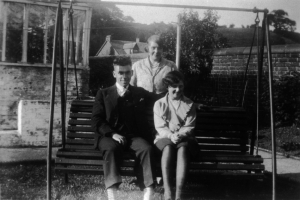
Annie visits Brookfield
The other lady in the picture is Marion, and I think that the man is a McWalter nephew.
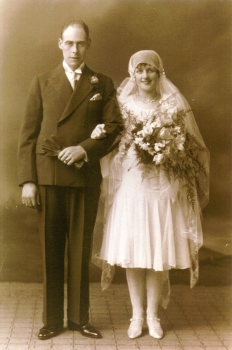
Bert and Annie married in July 1929 and settled in Kilmarnock, where they were both working. They both worked for Western SMT; Bert drove buses and Annie worked in the office. Later she worked in the wages office of Ayrshire Electricity Board.
In 1931 Herbert senior died aged only 54, from blood poisoning caused by infected gums after having some, maybe all, of his teeth extracted.
The oral history is that Herbert died intestate and so Bert, the oldest son, inherited his estate, which turned out to be only the house. I do not know whether it was expected that there would be cash or shares or bonds but I think that there were none. Marion would have been destitute, so Bert gave up his right to the house in favour of his mother.
It is also rather odd that there is no family stone at Herbert's grave; it is marked only by a small stone, in the form of an open book, from his work colleagues. The plot was bought in 1909 and the babies Thomas and John were buried there. I would have expected a stone with all three named on it. Presumably money was short and the small stone had to do. In 1958, Marion's ashes and in 1989, Hal's and Shirley's ashes were interred in the same grave.
I think that Bert and Annie had some problems early in their marriage. They split up for a time, Bert returning to his mother in Newmilns. I do not know whether this was before or after his father's death. However, the major problem was that Marion and Annie had a very bad relationship and that resulted in Marion having very little contact with them in the future.
I have been told that Bert and Annie visited Marion once, but I do not know whether this was pre- or post-war. Bert visited his mother fairly regularly after the war when he was on the Glasgow-London bus service and Marion was living in Reading with Hal & Shirley. Marion never returned to Scotland.
At the time of her father's death, Claire was engaged to Jim Houston, brother of, and business manager for, the Houston Sisters, Renée and Billie, who were enormously popular variety stars. The youngest sister Shirley Houston was also part of the act in later years, and I believe Claire may have appeared with them a few times. Claire had become friends with Renée in 1923, a year or two before The Houston Sisters first topped the bill. I have been told that the close friendship of the Silander and Houston families originated with Claire and Renée and that they met at a swimming pool.
Claire and Jim married 3 months later in London and settled in a house called "Carntyne" in Kenton in London. Marion sold "Brookfield" in Newmilns and she and Hal moved in with Claire and Jim, or maybe it was the other way round. The name "Carntyne" came from the village, eventually engulfed by Glasgow, where the Houstons had lived.
These photographs show Marion, Claire, Jim and Hal at "Carntyne". The photograph at Harrow swimming pool of Shirley and Claire is probably in 1931 as well.

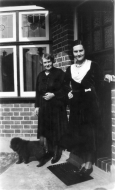
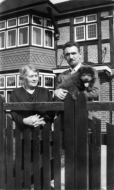
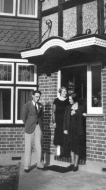
While at "Carntyne", Jim bred dogs, great danes and chow-chows, and quite successfully I believe. Later, when Jim was a best-selling author in the late 1930s, they moved to a bungalow in Benenden in Kent. Claire & Jim had a daughter, Elizabeth Pamela, but she died in infancy.
These pictures of the 3 Houston sisters are from the 1930s. Shirley at "Carntyne" with Panther, Pilot and Painter. Billie, who played the boy in the stage act, and Renée.
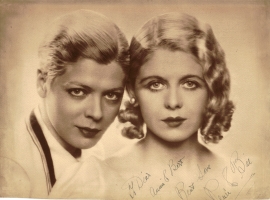
Billie, Renée
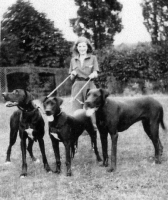
Shirley
Bert & Annie were living and working in Kilmarnock and started a family. Their first wee boy was still-born and in 1936 Herbert George was born. Sadly, he had spina bifida and died just before his 3rd birthday.
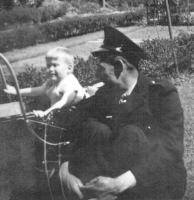
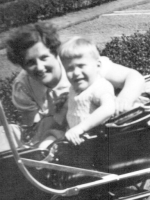
Around 1935, Jim Houston became James Alan Rennie and became a successful author and also a broadcaster eventually. He read his children's stories on BBC Radio in the 1950s. I think he coined Rennie from his sister's stage name Renée, and Alan from her son's name. Claire corrected and typed his manuscripts.
James Alan Rennie wrote several best-selling action novels. He also wrote under various pseudonyms; Boone Denver (Westerns), Morton Cleland (Hood, Morton, Cleland & Co was a lace mill in Newmilns) and Maxwell MacFee. I believe that in all he wrote 14 books; westerns, romantic adventure and historical non-fiction. His last book was the autobiographical "Past Horizons" in 1962. Jim was very talented and this book provides many insights into his adventurous life; well worth the read.
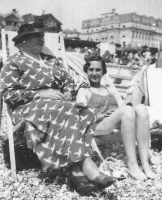
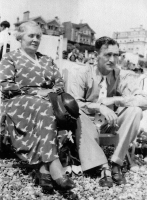
Here are a couple of holiday snaps of Marion with Claire and Jim in Eastbourne in the 1930s.
All too soon the world was at war again and Bert was drafted very early, in September 1939, having been a member of the Army Reserve since 1930. He was a driver in the Royal Army Service Corps and suffered at Dunkirk and returned to Europe in the Normandy landings.
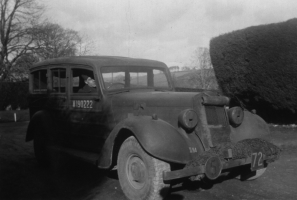
Bert in March 1940 ... somewhere in France?
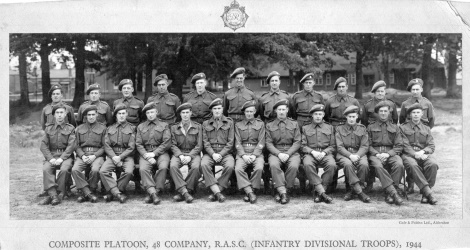
Bert in the RASC. Aldershot 1944.

Jim 1942
Jim had fought in World War I with the Royal Field Artillery and served as a Flying Officer in the RAF in World War II. His ulcers caused him to be invalided out in 1943/4.
At some stage, Hal became the manager of the Houston Sisters. Then Renée and Billie split up when Renée got a film contract. Billie and Shirley continued the Houston Sisters act but it did not go well and eventually Shirley, managed by Hal, continued successfully as a singer. Billie's health was not good and she retired in the mid-1930s, and wrote a successful crime novel.
In 1940 they moved out of the London area due to the threat of the bombs and settled in the village of Alveston near Stratford-upon-Avon. Marion and Hal were with Renée, Shirley and company, whose lives revolved around the theatre. Renée's household also comprised her current and future husbands, her 4 children, her parents and her grandmother. However, they found that the Midlands were not any safer and returned south within 2 years to Bourne End near Maidenhead in Bucks.
Marion is in the middle with Renée's children (from the right) Tony, Terry and Alan, and cook on the left.
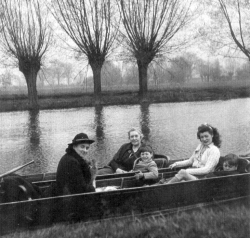
Punts on the Avon, 1940
Hal and Shirley were married in Alveston on Christmas Eve 1940. This picture shows Hal & Shirley with their mothers, Marion on the left and Lizzie.
Double-whammy - sister & brother married to brother & sister; Claire and Hal married to Jim and Shirley.
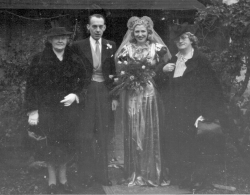
Hal and Shirley. Alveston. 1940.
Renée's children Tony and Alan knew Marion as Auntie May in the late 1930s and early 1940s. They recall how she was saddened by her impoverished circumstances compared to her position as the wife of an important man in Newmilns. She did not seem to appreciate the celebrity of her Houston in-laws and their connections with the theatre and Hollywood. Although she had a large extended family in Ayrshire, deriving from her 8 siblings and 13 aunts & uncles, as well as a son and eventually 3 grand-children, she never returned to Scotland. Amongst other factors, the falling-out between Marion and her daughter-in-law Annie must have been extremely serious.
Claire & Jim moved to Strathspey in 1943/4 and lived in a small-holding named Mid Port and then one named Milltown. They finally settled in Ballintian, just outside Cromdale, near Grantown-on-Spey. Their living conditions were very primitive compared to those that they left behind in London as these farms had no electricity and no mains water. Although they earned a little from the farms, their main income was from Jim's books, newspaper articles and broadcasts.
By the late 1940s, Marion was living with Hal and Shirley and family in Reading. She eventually moved to an old folks home in Wokingham where she died in 1958 at the age of 81. Meanwhile, Bert and Annie had a happier life following the war and brought up 3 children, though none of them ever met Marion.
To round off this short history, here are photographs of Marion and her children with their spouses.
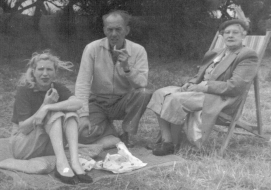
Shirley, Hal, Marion. About 1955.
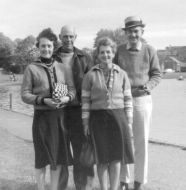
Claire, Bert, Annie, Jim. 1964
Many thanks to Tony Aherne for his comments and help.